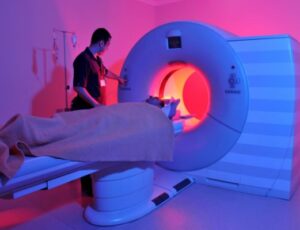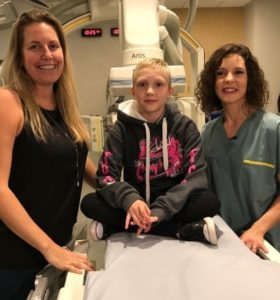
 When I’m stressed, I listen to a 20-minute mindfulness meditation tape. It always helps me feel calmer and more relaxed. Many meditative practices can do this.
When I’m stressed, I listen to a 20-minute mindfulness meditation tape. It always helps me feel calmer and more relaxed. Many meditative practices can do this.
Mindfulness meditation is getting a lot of attention because it seems to help with so many physical and psychological problems—like high blood pressure, chronic pain, psoriasis, sleep trouble, anxiety, and depression.
It’s also been shown to boost immune function and stop binge eating. No one knows for sure what’s behind these benefits, but physical changes in the brain probably play a role.
Mindfulness meditation is a mental discipline. You start by focusing your attention on your breath, a sensation in the body, or a chosen word or phrase.
You note the thoughts, emotions, and background sounds that arise from moment to moment, observing them without analyzing them or making judgments about what’s going on around you.
If you drift into thoughts about the past or concerns about the future, you bring your attention back to the present, for example, by refocusing on your breathing. It takes practice.
A new study, published in the May 2011 issue of Neuroimage, suggests that one effect of all this focusing and refocusing is increased brain connectivity. Researchers at the University of California-Los Angeles compared the brain activity of volunteers who had finished eight weeks of mindfulness-based stress reduction training with that of volunteers who did not do such training.
Functional MRI scans showed stronger connections in several regions of the meditators’ brains—especially those associated with attention and auditory and visual processing.
Unfortunately, the study didn’t scan the volunteers’ brains before mindfulness training, so no one can say for sure that mindfulness training was responsible for the differences.
At Massachusetts General Hospital, researchers used MRI scans to document before and after changes in the brain’s gray matter—the “processing” neurons—associated with mindfulness meditation.
The density of gray matter increased in regions governing such distinctly different activities as memory, self-awareness, and compassion, and decreased in the amygdala—the part of the brain associated with fear and stress.
We covered this intriguing research in the April issue of Harvard Women’s Health Watch.
At the moment, scientists can only speculate about the relationship between these brain changes and the health benefits associated with mindfulness meditation.
But the research adds to growing evidence that meditative practices can alter the body at a fundamental level—even, it turns out, at the level of our genes.
 Meditation elicits the “relaxation response,” a state of deep relaxation first described more than 35 years ago by mind-body pioneer Dr. Herbert Benson, currently emeritus director of the Benson-Henry Institute of Mind-Body Medicine at Massachusetts General Hospital.
Meditation elicits the “relaxation response,” a state of deep relaxation first described more than 35 years ago by mind-body pioneer Dr. Herbert Benson, currently emeritus director of the Benson-Henry Institute of Mind-Body Medicine at Massachusetts General Hospital.
Since then, Benson and his colleagues at Massachusetts General Hospital and Beth Israel Deaconess Medical Center have discovered that relaxation techniques (including meditation and yoga) turn certain sets of genes on and off in people who practice them regularly.
Benson, who is the medical editor of Stress Management: Approaches for preventing and reducing stress says these genes are involved with controlling “how the body handles free radicals, inflammation processes, and cell death.”
By: Carolyn Schatz

 The intervention is called mindful hypnotherapy. “Mindfulness is a type of meditation that involves focusing attention on present moment awareness.
The intervention is called mindful hypnotherapy. “Mindfulness is a type of meditation that involves focusing attention on present moment awareness.
It can help people cope with stress, but can require months of practice and training,” said researcher Gary Elkins, Ph.D., director of the Mind-Body Medicine Research Laboratory at Baylor University.
“Hypnosis also involves focusing attention, but it includes mental imagery, relaxation and suggestions for symptom reduction.”
Hypnosis interventions are typically brief and have been used in pain and symptom management in clinical practice. The study’s basic premise is that using hypnosis to deliver mindfulness goals could have many advantages, Elkins said.
“Combining mindfulness and hypnotherapy in a single session is a novel intervention that may be equal to or better than existing treatments, with the advantage of being more time-effective, less daunting and easier to use,” he said. “This could be a valuable option for treating anxiety and stress reduction.”
As a brief intervention, mindful therapy could be widely disseminated and is an innovative new mind-body therapy. The study is published in the International Journal of Clinical and Experimental Hypnosis.
Elkins noted that while mindfulness by itself can be an effective treatment for stress and anxiety for some people, it typically is provided in eight weekly sessions that last two hours or more each week and include an all-day retreat of eight or more hours.
all-day retreat of eight or more hours.
That amount of time, more than 24 therapy hours, may be a burden in cost and time for some people. Also, research has not shown that mindfulness-based treatments are consistently superior to standard cognitive behavioral therapy, he said.
For the study of mindful hypnotherapy, the Baylor research team recruited 42 individuals with self-reported high stress. Half took part in an intervention of one-hour weekly individual sessions that included hypnosis inductions and suggestions for greater mindfulness.
Participants also were given self-hypnosis audio recordings lasting about 20 minutes, each with suggestions for a hypnotic induction, relaxation and greater mindfulness.
The second group did not take part in the intervention. Intervention material focused on present-moment awareness, nonjudgmental awareness of the five senses, nonjudgmental awareness of thoughts and feelings, self-hypnosis, compassion for self and others, awareness of personal values and meaning in life and transition to long-term practice of mindful hypnotherapy, Elkins said.
 At study’s end, the intervention group reported a large decrease in stress and a significant increase in mindfulness. Most were highly satisfied with the number of sessions, the ease of home practice and the clarity of content, Elkins said.
At study’s end, the intervention group reported a large decrease in stress and a significant increase in mindfulness. Most were highly satisfied with the number of sessions, the ease of home practice and the clarity of content, Elkins said.
The average participant practiced almost every day, and overall satisfaction with the intervention was 8.9 on a scale of 10.
In comparison, those who did not participate in the intervention reported no significant difference between pre- and post-study stress level. A limitation of the study was its small sample size, Elkins said.
Future studies of a larger number of people could be of value, as well as testing mindful hypnotherapy for such concerns as anxiety, depression or chronic pain, he said.

 1. Of about 80,000 people sick from COVID-19 in China, more than 70% have recovered and been discharged from hospitals. Per the World Health Organization last week, “Of the 80,000 reported COVID-19 cases in China, more than 70% have recovered and been discharged.”
1. Of about 80,000 people sick from COVID-19 in China, more than 70% have recovered and been discharged from hospitals. Per the World Health Organization last week, “Of the 80,000 reported COVID-19 cases in China, more than 70% have recovered and been discharged.”
2. Scientists have figured out how the novel coronavirus breaks into human cells, which will help significantly in developing treatments. After scientists revealed the first picture of how the novel coronavirus binds with human respiratory cells to produce more viruses, researchers in China have solidified images all the way down to the level of the atoms at the binding points, according to Live Science. With this news, understanding how the virus enters cells will significantly aid researchers in finding drugs and vaccines to fight the virus.
3. Due to high levels of self-quarantine, Codogno, one of the two coronavirus clusters in Italy, has reported significantly fewer infections per day compared to 35 cases per day at the beginning of the outbreak, just five new infections were announced last week by Codogno’s mayor, Francesco Passerini, according to the U.S. News and World Report.
“It is a war. It is a war, but we have every possibility of winning,” Passerini said. “Unlike with our grandfathers, who went physically into battle for our freedom, we are being required to show responsibility — responsibility and calm.”
4. Scientists in Canada have made massive breakthroughs in an effort to develop a vaccine. A team of Canadian scientists has finally isolated and grown copies of the coronavirus, which may now help scientists study the pathogen to develop better testing, treatments, vaccines, and gain a better understanding of its biology, the team said in a statement alongside the New York Post.
5. China is testing five different vaccine options, claiming it could have a vaccine ready by next month. Eight different institutes in China are working on five different inoculations to battle the novel coronavirus, according to the South China Morning Post.
“According to our estimates, we are hopeful that in April some of the vaccines will enter clinical research or be of use in emergency situations,” said Zheng Zhongwei, director of the National Health Commission’s Science and Technology Development Center.
While it’s true that it would take at least 12 to 18 months to provide a safe vaccine to general public, under Chinese law, they could be released sooner for urgent use in a major public health emergency, provided the benefits outweigh the risks, noted the New York Post.
6. Vaccination trials in the U.S. are already underway. A trial of Moderna’s vaccine has already kickstarted at Kaiser Permanente under Washington’s Health  Research Institute in Seattle, of which will hopefully confirm the safety of the vaccine prior to mass production.
Research Institute in Seattle, of which will hopefully confirm the safety of the vaccine prior to mass production.
7. A team of infectious disease experts calculated the fatality rate of Wuhan’s coronavirus outbreak is about 1.4%, drastically lower than earlier estimates. While this estimate and data applies directly to Wuhan, where the novel coronavirus outbreak began, it offers a hopeful guide to the rest of the world as it notes significantly lower estimate of earlier stats around 3%. A full breakdown of the data can be found at Stat News.
8. Distilleries across the U.S. are making their own hand sanitizers and giving it away for free. Perhaps many Americans can calm down on the panic buying, as according to the Associated Press, distilleries across the country are using high-proof alcohol to make hand sanitizer, and divvying it out for free, or by donation to combat the novel coronavirus.
9. Air pollution has plummeted in cities with high numbers of quarantined individuals, Venice’s waters are running clear. Analysts from the Washington Post have noted a drastic decrease in major greenhouses gases over Europe as individuals self-quarantine and cars stay parked at home. While it’s little comfort to a country ravaged by the novel coronavirus, it highlights the impact humans can make on the environment.
“I expect pollution to drop even further as the particles in the atmosphere get either dispersed or absorbed,” Emanuele Massetti, an expert on the economics of climate change at Georgia Tech University who has studied Italy’s climate policies, told the Washington Post. “In a few days, they will enjoy the cleanest air ever in northern Italy.”
10. A Johns Hopkins researcher has claimed antibodies from recovered coronavirus patients could help protect people at risk. A treatment that can be made readily available under urgent circumstances, a team from Johns Hopkins alongside many other researchers are studying whether or not the antibodies of those recovered from the coronavirus could help protect at-risk humans from the virus.
“Deployment of this option requires no research or development,” immunologist Arturo Casadevall told Science Alert. “It could be deployed within a couple of weeks since it relies on standard blood-banking practices.” Not to mention, a Japanese pharmaceutical company is nearing approval of the treatment.
11. South Korea recoveries are starting to outnumber new infections. Facing the largest epidemic outside of China, South Korea reported more recoveries from the coronavirus than new infections on Friday for the first time since its outbreak emerged in January, as a downward trend in daily cases raised hopes that Asia’s biggest epidemic outside China may be slowing, according to India Today.
 12. China is getting its feet back on the ground, opening parks and athletics, loosening travel restrictions. As the novel coronavirus comes under control in China, parks and tourist attractions have reopened across the country, alongside loosened travel restrictions.
12. China is getting its feet back on the ground, opening parks and athletics, loosening travel restrictions. As the novel coronavirus comes under control in China, parks and tourist attractions have reopened across the country, alongside loosened travel restrictions.
“The National Health Commission said on Thursday that the outbreak had passed its peak, and the figures appear to support its claim,” said the South China Morning Post. “On Friday, authorities in mainland China reported just 11 new Covid-19 cases, of which four were in Hubei.” According to ESPN, even professional basketball has reemerged in Asia.
13. China has also closed its last coronavirus hospital, not enough new cases to support them. China has shut down all 16 temporary coronavirus hospitals in Wuhan as cases of coronavirus have begun to dwindle. “The final group of 49 patients walked out of the Wuchang temporary hospital in the capital of Hubei province on Tuesday afternoon to cheers,” according to the Xinhua news agency.
14. Australian researchers are in the midst of testing two drugs as cures to the virus. Scientists in Australia claim to have identified how the body’s immune system fights the novel coronavirus.
Published in Nature Medicine journal on Tuesday, the research shows people are recovering from the virus like they would from the flu. “This [discovery] is important because it is the first time where we are really understanding how our immune system fights novel coronavirus,” study co-author Prof Katherine Kedzierska told BBC News.
15. Numerous businesses have stepped up to solve the crisis. Restaurants, sports, and businesses are all stepping up to combat the community effects of the novel coronavirus.
The sports world is raising money for stadium employees, Uber Eats is divvying out free delivery to help independent restaurants, professional soccer players are entertaining viewers with a FIFA tournament, restaurants are doling out free food to those in need, and Bill Gates is funneling out millions of dollars to speed up development of a coronavirus treatment, to name just a few out of dozens.
16. Apple, Starbucks reopening all stores in China. While stores and restaurants across the U.S. have closed up shop, both Apple and Starbucks have reopened all of their stores in China as the novel coronavirus spread slows across the country.
17. MetroHealthMedical Center has developed a coronavirus test that gives results in hours, not days. “MetroHealth Medical Center becomes the first hospital in the state that can now test COVID-19 samples at its laboratory with results available after just two hours,” released News 5 Cleveland. While supplies are limited, it notes a significant step toward expansive testing of the novel coronavirus.
18. Scientists in Israel have also noted the potential to announce development of a coronavirus vaccine within weeks. Israeli scientists are nearing development of ![]()
 the first vaccine to combat the novel coronavirus, according to Science and Technology Minister Ofir Akunis. The vaccine could be ready within a few weeks and available in 90 days, according to a release.
the first vaccine to combat the novel coronavirus, according to Science and Technology Minister Ofir Akunis. The vaccine could be ready within a few weeks and available in 90 days, according to a release.
19. A San Diego biotech company is developing a coronavirus vaccine in collaboration with Duke University and National University of Singapore. As the race to develop a vaccine for the novel coronavirus continues globally, the San Diego-based biotech company, Arcturus Therapeutics, is working on creating one at its lab.
The company is working alongside Duke NUS-Medical School, a partnership between Duke University and the National University of Singapore. While developing a vaccine that works hasn’t yet proven impossible, “The major challenge with vaccines is the size of the dose and the feasibility of manufacturing,” President and CEO, Joseph Payne, told CBS8.
20. A Japanese flu drug has proven effective in treating the novel coronavirus. Zhang Xinmin, an official at China’s science and technology ministry, said favipiravir, developed by a subsidiary of Fujifilm, had produced encouraging outcomes in clinical trials in Wuhan and Shenzhen involving 340 patients, according to The Guardian. “It has a high degree of safety and is clearly effective in treatment,” Zhang told reporters on Tuesday.
21. China has reported just one new domestic coronavirus infection for a second day in a row. “For the second consecutive day there was only one more fresh infection in Wuhan, the central city where the virus first emerged late last year,” said the National Health Commission. New cases in surrounding Hubei province have now been in the single digits for the past seven days, down from a peak of several thousand per day in early February, said Daily Mail.
22. Communities are coming together to help their neighbors. Neighbors across the country are stepping up to make grocery runs for those who can’t leave their homes. Local services have also reached out to the Seattle community to encourage those in need of help, to utilize the opportunities available to them.
23. A 103-year-old Chinese grandmother has made a full recovery from COVID-19. After being treated for less than a week, this grandma is going for the gold as the oldest coronavirus patient to recover in China, and motivating elderly across the globe to retain hope.
By: Christina Ausley, Seattle PI

 Some 80 pediatric patients took part in pilot project to test effect of hypnosis during stressful procedures.
Some 80 pediatric patients took part in pilot project to test effect of hypnosis during stressful procedures.
Even in a quick demonstration, Vicky Fortin, medical imaging technologist, was able to guide 9-year-old Koraly Lefrançois into a dreamlike state with hypnosis.
Koraly Lefrançois was diagnosed with Hodgkin’s disease last April and has had to undergo some pretty uncomfortable medical procedures at the Montreal Children’s Hospital since then.
The nine-year-old has had a catheter inserted into a peripheral vein and threaded through to her heart, in order for lifesaving treatments to be injected. She underwent a biopsy when a growth was discovered on her inner thigh.
In both procedures, a local anesthetic was used to ease her pain. But that does little to soothe anxiety.
That’s where hypnosis comes in.
“At first I was stressed, but after, I was less worried,” Koraly said. “The hypnosis calmed me down, and I was fine.”
Koraly is one of about 80 pediatric patients who participated in what is being touted as a successful pilot project at the Children’s — the use of medical hypnosis as a tool to combat stress and pain when undergoing arduous, protracted procedures.
On a pain and discomfort scale of zero to 10 (10 being the highest), the young patients averaged a score of 5.4 without hypnosis, researchers found.
Under hypnosis, the average score drops to 1.4. That’s a huge difference, said Johanne L’Écuyer, chief medical imaging technologist at the  Children’s.
Children’s.
Inspired by hospitals in France
L’Écuyer, who led the project, said the research team started with minor procedures, working their way up to longer, more difficult ones. The project ended in September, and now the use of hypnosis is increasingly common, she said.
“We do more and more. We do even more invasive procedures as we go,” L’Écuyer said.
“The more radiologists are seeing how powerful this is, the more they push to have hypnosis on longer procedures. Once we did a procedure that lasted two hours.”
Johanne L’Écuyer, chief medical imaging technologist at the Montreal Children’s, led the hypnosis pilot project. Hypnosis is now being used more and more, she says. (CBC)
The pilot project was initiated at the urging of Quebec’s order of medical imaging technologists. The order’s director attended a conference in France a few years ago and discovered the practice in use there.
When he returned to the province, he asked L’Écuyer if she’d like to look into it.
 She said she brought a team to France to visit hospitals, and “what we saw there was amazing.”
She said she brought a team to France to visit hospitals, and “what we saw there was amazing.”
Anne Zeestraten, left, says her daughter Koraly Lefrançois benefited from the hypnosis. Vicky Fortin, Koraly’s medical imaging technologist, says she could see her patient dreaming.
Koraly, who is now in remission, would dream while hypnotized, according to her medical imaging technologist, Vicky Fortin. Fortin would tell her young patient a relaxing story while she underwent each procedure.
“You could see her eyes moving under her eyelids, and that tells me that she’s dreaming,” Fortin recalled.”She’s somewhere else. She’s under hypnosis.” Koraly’s mother, Anne Zeestraten, said with the hypnosis, her daughter wasn’t scared when told she had to undergo a second procedure.
“She was like, ‘OK, yeah, just find some other dream.'”
By: Isaac Olson

 This study checks out is effective and safe for people suffering from irritable bowel syndrome (IBS).
This study checks out is effective and safe for people suffering from irritable bowel syndrome (IBS).
A total of 464 patients received 7–12 hypnosis sessions over a 12 week period. At the end of therapy, hypnosis proved to be superior in producing adequate symptom relief.
This study demonstrated that hypnosis was safe and provided long-term adequate symptom relief in 54% of IBS patients compared to conventional therapy. [more]

 A meta-analysis examines treatments like meditation and cognitive behavioral therapy as alternatives for alleviating pain that is typically treated with opioids.
A meta-analysis examines treatments like meditation and cognitive behavioral therapy as alternatives for alleviating pain that is typically treated with opioids.
The more we learn about opioids, the clearer it becomes that there’s no simple solution to the opioid crisis and the cycle of dependency and misuse that has already impacted millions of Americans.
It’s especially difficult given how effective opioids are at pain management, particularly the kind of acute, short-term pain associated with cancer treatment or surgical or injury recovery.
Researchers are actively seeking alternatives to opioids when it comes to pain management—and a meta-study tracking the efficacy of mind-body therapies for treating pain that was previously managed with opioids indicates that some MBTs could act as effective pain management treatments, as well as tools for helping reduce opioid use and dependency.
The survey examined 60 studies looking at the effectiveness of “psychologically oriented MBTs,” including meditation, hypnosis, guided imagery, relaxation, cognitive behavioral therapy, and therapeutic suggestion, at pain management and/or opioid use outcomes.
The overview found a moderately significant association between MBTs and pain reduction and a smaller significant association between MBTs and reduction of opioid doses, as well as some relationship between MBTs and the treatment of opioid misuse and cravings.
Meditation was found to have the strongest correlation with pain reduction. The five meditation-related studies reviewed all showed participants experiencing some level of pain relief from the therapeutic treatment.
Four of the five studies also found meditation and mindfulness resulted in “opioid-related outcomes,” including decrease in opioid dosage, decreased cessation time, and dips in opioid misuse and cravings.
Hypnosis and CBT were also associated with positive opioid-related outcomes, with 12 of 23 hypnosis studies and four of the seven CBT studies reviewed showing “significant therapeutic effects” on opioid use.
Eric Garland, the study’s lead author, said his background in social work led him to a better understanding of the relationship between MBTs and pain, as well as the one between MBTs and opioids. “I’m a licensed clinical social worker,” Garland told VICE. “I’ve used mind-body therapies both for the treatment of chronic pain as well as the treatment of addictive behaviors.”
He said opioid misuse, pain, and MBTs all have one major factor in common: the brain. “Mind-body therapies make a lot of sense for the treatment of pain since all pain is in the brain.
If you use a technique that changes the way the brain functions, that changes the way the brain interprets signals from the body and therefore it will affect the experience of pain, as well as the person’s emotional reaction to pain.”
Since long-term opioid use can lead to brain changes like opioid tolerance and a loss of the ability to self-regulate opioid usage, MBTs can play a dual role for someone already using prescription drugs to manage their pain, Garland said.
“[MBTs] are all about teaching people a way to regain some of that control over the function of the brain and so therefore it can be useful not only for reducing the pain and helping the patient manage the pain, but also helping them gain better control over their opioid use itself.”
Does this mean people with opioid use disorder or who are living with pain from other medical procedures can ditch the Oxycontin and just fire up a ‘Yoga with Adrienne’ video? Of course not.
 Research has shown that mindfulness and opioids don’t operate on the same parts of the brain, for starters, which means MBTs are a better side-by-side treatment than a ready-made substitute for medication.
Research has shown that mindfulness and opioids don’t operate on the same parts of the brain, for starters, which means MBTs are a better side-by-side treatment than a ready-made substitute for medication.
The 60 studies surveyed included a total of 6404 participants who were already taking opioids, which averages out to around 100 people per study—a sample group too small to base conclusive solutions on.
Authors were careful to note that different MBTs were applied to different types of pain, with meditation studies tending to target chronic pain while hypnosis, relaxation, therapeutic suggestion and guided imagery treatments were more likely to be applied to acute pain.
Garland also said in the future, he hopes more research will focus on the relationship between MBTs and opioid use, rather than just the relationship between MBTs and pain.
By: Katie Way

 When I’m stressed, I listen to a 20-minute mindfulness meditation tape. It always helps me feel calmer and more relaxed. Many meditative practices can do this.
When I’m stressed, I listen to a 20-minute mindfulness meditation tape. It always helps me feel calmer and more relaxed. Many meditative practices can do this.
 Meditation elicits the “relaxation response,” a state of deep relaxation first described more than 35 years ago by mind-body pioneer Dr. Herbert Benson, currently emeritus director of the Benson-Henry Institute of Mind-Body Medicine at Massachusetts General Hospital.
Meditation elicits the “relaxation response,” a state of deep relaxation first described more than 35 years ago by mind-body pioneer Dr. Herbert Benson, currently emeritus director of the Benson-Henry Institute of Mind-Body Medicine at Massachusetts General Hospital.
 The intervention is called mindful hypnotherapy. “Mindfulness is a type of meditation that involves focusing attention on present moment awareness.
The intervention is called mindful hypnotherapy. “Mindfulness is a type of meditation that involves focusing attention on present moment awareness. all-day retreat of eight or more hours.
all-day retreat of eight or more hours. At study’s end, the intervention group reported a large decrease in stress and a significant increase in mindfulness. Most were highly satisfied with the number of sessions, the ease of home practice and the clarity of content, Elkins said.
At study’s end, the intervention group reported a large decrease in stress and a significant increase in mindfulness. Most were highly satisfied with the number of sessions, the ease of home practice and the clarity of content, Elkins said.
 1. Of about 80,000 people sick from COVID-19 in China, more than 70% have recovered and been discharged from hospitals. Per the World Health Organization last week, “Of the 80,000 reported COVID-19 cases in China, more than 70% have recovered and been discharged.”
1. Of about 80,000 people sick from COVID-19 in China, more than 70% have recovered and been discharged from hospitals. Per the World Health Organization last week, “Of the 80,000 reported COVID-19 cases in China, more than 70% have recovered and been discharged.” Research Institute in Seattle, of which will hopefully confirm the safety of the vaccine prior to mass production.
Research Institute in Seattle, of which will hopefully confirm the safety of the vaccine prior to mass production. 12. China is getting its feet back on the ground, opening parks and athletics, loosening travel restrictions. As the novel coronavirus comes under control in China, parks and tourist attractions have reopened across the country, alongside loosened travel restrictions.
12. China is getting its feet back on the ground, opening parks and athletics, loosening travel restrictions. As the novel coronavirus comes under control in China, parks and tourist attractions have reopened across the country, alongside loosened travel restrictions. the first vaccine to combat the novel coronavirus, according to Science and Technology Minister Ofir Akunis. The vaccine could be ready within a few weeks and available in 90 days, according to a release.
the first vaccine to combat the novel coronavirus, according to Science and Technology Minister Ofir Akunis. The vaccine could be ready within a few weeks and available in 90 days, according to a release.
 Some 80 pediatric patients took part in pilot project to test effect of hypnosis during stressful procedures.
Some 80 pediatric patients took part in pilot project to test effect of hypnosis during stressful procedures. Children’s.
Children’s. She said she brought a team to France to visit hospitals, and “what we saw there was amazing.”
She said she brought a team to France to visit hospitals, and “what we saw there was amazing.”
 This study checks out is effective and safe for people suffering from irritable bowel syndrome (IBS).
This study checks out is effective and safe for people suffering from irritable bowel syndrome (IBS).
 A meta-analysis examines treatments like meditation and cognitive behavioral therapy as alternatives for alleviating pain that is typically treated with opioids.
A meta-analysis examines treatments like meditation and cognitive behavioral therapy as alternatives for alleviating pain that is typically treated with opioids.
 Research has shown that mindfulness and opioids don’t operate on the same parts of the brain, for starters, which means MBTs are a better side-by-side treatment than a ready-made substitute for medication.
Research has shown that mindfulness and opioids don’t operate on the same parts of the brain, for starters, which means MBTs are a better side-by-side treatment than a ready-made substitute for medication.







